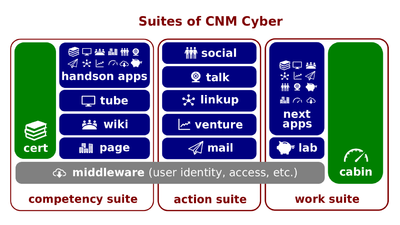Project Parties and Roles
Project Parties and Roles (hereinafter, the Lectio) is the lesson part of Project Work Essentials lesson that introduces its participants to project management concepts. This lesson belongs to the CNMCT Entrance section of CNMCyber Bootcamps.
Content
The predecessor lectio is What Project Work Is.
Script
- No doubts; no one has to hire a helper to buy a bicycle. Work on bigger and costlier projects commonly involves two parties. Development administration is one party; this person or people order and finance work products. Project management is another party; that person or people deliver the ordered products.
- Both parties may belong to one organization. Otherwise, the organization that orders the project is called a project customer. The organization that delivers project results is called is a project owner.
- The project owner is responsible for project management. To direct, monitor, and/or support project personnel, the owner may set up a project management office, often abbreviated as PMO.
- In management of Waterfall projects, a project manager is the key role. These managers concentrate on development of approved products at approved budgets and on approved schedules.
- A project manager leads project planning until baselines are approved, project executing until deliverables are validated, and project closing. For the planning stage, a manager may hire business analysts to collect requirements and systems engineers to design a system as a solution. Those developers that directly create deliverables are hired only for the executing stage.
- If project personnel is fewer than 5-9 people and the schedule is not compressed, the manager is rarely a dedicated role. One of developers or someone else may act as the project manager in addition to other responsibilities.
- In Agile, management functions are distributed between several roles. For instance, developers define work based on solution requirements such as user stories.
- In the planning stage, some coordinator, for instance, an account manager working for PMO, hires members of the planning team in addition to the product owner. This team conducts Sprint Zero or a similar activity undertaken to create a product backlog.
- The development team is hired for the executing stage. Besides the product owner, that team consists of developers, and, possibly, a ceremonial role such as a Scrum Master. Developers usually work in iterations and, as soon as new increments are developed and new data is discovered, discuss the future product and its delivery with the product owner. Scrum Masters don't deal with work products and deliveries; instead, Scrum Masters make sure that the development goes according to the agreed rules.
- Unlike project management, development administration is often distributed between two organizations if two organizations are involved in one project.
- The project customer identifies a business need, which is a problem to be solved, initiates a project to create a solution, and provides the budget for the project.
- The project owner, consequently, hires someone who acts on behalf of the customer while approving solution requirements, project baselines, and/or assessing whether the work product meets acceptance criteria.
- In Waterfall projects, this administrative role is called project sponsor. Baselines is not a feature of Agile projects, so the administration concentrates on product requirements only.
- A product owner is the key administrative role in Agile projects. This person concentrates on envisioning of the right product, describing that product usually using user stories, and prioritizing the product backlog. Product owners do not deal with budgets, schedules, as well as other management functions such as hiring and procurement. The area of responsibility of product owner is making sure that the customer's money are spent on the product that the customer looks for.
Key terms
- Project party, development administration, project management, project customer, project owner, project personnel, project management office (PMO), project manager, project baseline, business analyst, systems engineer, Scrum Master, business need, project sponsor, product owner
Closing
- Write True or False:
- Project owner refers to direct customer who owns and finances the project.
The successor learning activity is CNMCT Entrance Exam.
